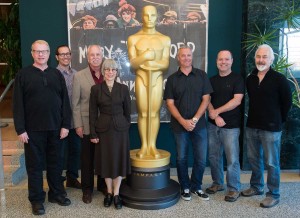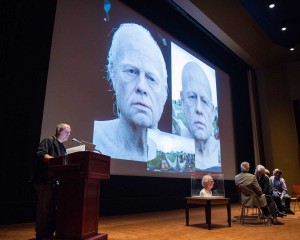
From the earliest silent shorts, using primitive paints, putties and other primal physical materials, makeup has been essential to the appearance of actors on film. As the decades progressed, so did makeup techniques. As better quality materials became available to artists, prosthetics were developed which when applied, would more definitively change an actor’s visage on screen. More flexible and realistic materials, including foam latex, gelatins and silicones became available, and mechanical apparatuses could be embedded inside said prosthetics to add a new level of makeup realism. Then, after the advent and refinement of computer-based manipulation of images, a hybrid approach was developed – adding digital features to practical makeups.
On April 22, the Academy of Motion Picture Arts and Sciences presented the seminar and panel discussion, “Blending Makeup with Digital Arts in Film,” at the Linwood Dunn Theater in Hollywood, Calif. Hosted by Academy makeup branch governor Leonard Engelman, the expert panelists included Oscar-winning animation supervisor Steve Preeg, seven time Oscar-winning makeup/creature artist Rick Baker, three time Oscar-winning makeup artist Greg Cannom, Oscar-winning creature animation supervisor Hal Hickel, Oscar-winning makeup artist Lois Burwell, and visual effects supervisor Edson Williams.
First and foremost at the seminar, in perhaps the purest blend of digital arts and makeup in film history, The Curious Case of Benjamin Button was thoroughly examined and discussed as many of the evening’s participants worked on that project. The fantastical story device in Benjamin Button concerned the titular character, played by Brad Pitt, aging in reverse, so he is born with the qualities of a geriatric man, and, as the years progress, attains more youthful attributes. Creating this illusion involved many different effects techniques and personnel.
First, Baker’s team at his Cinovation facility, which included Baker protégé Kazuhiro Tsuji, created an extreme old age makeup sculpture on Pitt’s lifecast. That bust of Pitt as an aged man was used by digital artists supervised by Preeg who scanned in and created a digital version of Pitt’s oldest age stage. Then, on set, director David Fincher filmed a small adult male wearing a grey hood. These scenes were to resemble Pitt’s body in his character’s oldest appearances. Pitt’s digital face was then replaced over the actor from the live-action photography. Additional facial capture photography of Pitt was utilized to animate Pitt’s digital facial replacements.
Meanwhile on Button, Cannom and his Captive Audience studio created additional finely detailed prosthetic makeups of Pitt at other various age stages – this work brought Cannom his third Oscar. Only for early middle-age stages was Pitt wearing a minimum of makeup. For scenes where Pitt’s screen appearance became younger than Pitt’s normal appearance, Lola VFX, supervised by Williams, would digitally enhance Pitt’s face and hands, erasing wrinkles, lifting cheeks and removing other facial elements. Lola had done this type of unprecedented work previously on X-Men: The Last Stand and has since done so on the final Harry Potter film, in delicately aging its youthful cast, and on Tron: Legacy, in making actor Jeff Bridges look decades his junior. Unquestionably, with this newfound ability of digital artists to make actors look significantly younger, practical techniques, such as using adhesive lifts, prosthetics, paints and implants are being outmoded in the eyes of select filmmakers.

Of course, despite the visual evidence as to the power of digital, there are many opinions about the hybrid techniques in both the practical makeup and digital camps. For one, Hickel noted that practical elements are crucial for his digital tools to work at their most potent levels. In one example, he cited the Davy Jones character played by Bill Nighy in the Pirates of the Caribbean films, noting that having Nighy perform the character was vital to acquire his nuanced performance with motion-capture cameras, which was then translated into a digital performance with Davy Jones’ facially tentacled attributes added by Industrial Light and Magic. “Mo-cap was indispensible,” Hickel said. “We were partnering with Bill Nighy. Motion-capture was the right tool for the job.”
In another instance, Hickel was tasked with digitally realizing the key alien creature for the J.J. Abrams film Super 8. By the time Hickel came aboard, artist Neville Page had already designed the creature on a computer using Z-Brush. “I joined the film later in the process than is usual for me,” said Hickel. “I focused on the creature. J.J. did a motion-capture session with Bruce Greenwood. It was a bit too human. We veered away from it and created key-frame animation.”
For a film which followed the model of Jurassic Park and employed both practical on-set effects and summative digital effects, the original Men in Black used Baker’s evident design and manufacturing talents. The show garnered an Oscar for Baker for its many makeups and creatures, but the Edgar creature for the film’s final scenes became a point of controversy for the filmmaking team. “We designed a bug that was a nightmare in that there were so many people involved wanting changes,” Baker recalled. He noted that the ultimate design, preferred by the director and producers, looked too reptilian. “We built three full-size mechanical things. We weren’t going to shoot it – ‘we’ll do it all CG because it looks too much like a bug.’ It was a disappointment in that we spent a lot of time, effort and money into something that wasn’t in the film.”
In the non-creature arena, basic makeup application itself is being scrutinized with claims that various films have been digitally altered, rendering them not purely makeup-oriented. With her most recent project, Lincoln, containing the non-digital makeup triumphs of its titular character, plus a large supporting cast, Lois Burwell is hesitant to jump on the digital bandwagon. “Doing [digital arts] is tempting, but it’s like letting a child be in a sweet shop,” she said. “I don’t think it’s particularly good for us then or now. Making choices and decisions during the filmmaking process and committing to your vision, and knowing what your vision is, is part of the skill set of filmmaking. Putting it at the end is not responsible.”
Having done several other Steven Spielberg-directed projects, Burwell pointed to Spielberg’s very careful facility with implementing on-set techniques and digital tools, mostly created in postproduction. “He’s a wonderful filmmaker and knows what he wants,” Burwell said of Spielberg. “He has a vision and is very generous as a filmmaker. You can come up with something that adds to his vision. He has one of the fastest minds and can take it, use it and take something from it. Sometimes, you have to come up with something in that moment, in the circumstance.”
In an example of Spielberg’s decision-making process combined with his reliance on practical makeup effects, Burwell noted the process of achieving Daniel Day-Lewis’ final appearance in Lincoln. “There were three tests,” she said of conceiving and refining the Lincoln makeup. “One was a test for Sally Field. The second time we flew to Ireland to see if our thoughts would match and work for Steven and Daniel. The only time he went on camera was on a pre-shoot day when Mr. Lincoln is in front of the fire.”
In addition to a prosthetic mole and “ear pushers,” Burwell and makeup artist Kenny Myers used an 80-year-old technique of stretch and stipple to create the Lincoln makeup. “We paint the skin underneath and paint it on in different layers, drying in between on the face, neck and hands, and over-painted,” Burwell said.
For the aftermath of the majority of the film when Lincoln is told that he has visibly aged through the ordeal of the Civil War, Burwell and Myers created an even older Lincoln, again with on-set practical makeup. “It was more painting, and I let some of the white come through in the beard more,” she said. “The process is the same, but it’s the degree and what you do with your hand, and the eye that you are applying it with.”
Though she cited Saving Private Ryan as another of her personal favorites in her career, Burwell noted Lincoln as the film which best represents the totality of her abilities. “Lincoln was the coming together of every skill that I’ve used over the years – almost seamless,“ she said.
Certainly, in addition to the on-set majesty of a Burwell, practical artists such as Baker and Cannom will be in demand for the foreseeable future as designers and producers of wondrous characters. To what degree such trusted methods will be replaced by digital artists remains unclear. Baker noted working on a project which never came to fruition in which, through digital means, Bruce Lee would be brought back to life for a film. In that case, Baker would be invaluable to digital artists for, at minimum, the initial design and production work. With the digital modifications that artists such as Preeg, Hickel and Williams can afford, a hybrid approach as with Benjamin Button seems the most likely avenue for filmmakers in the upcoming decades.
Most on the panel agreed that the cinematic necessity for having living actors create original performances, regardless of how those dramatizations are rendered, manipulated and viewed in a final film, will never completely disappear.
Naturally, each project warrants its own approach, be it practical makeup, digital effects or a combination. Asked how the decision is made as to which technique is used on a film today, Baker stated that the choice is made, “By the most powerful person in the room.”





